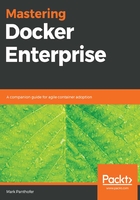
Moving from science projects to production platforms
In the early days, and for containers up until about the middle of 2017, Docker-based applications look more like science projects than well engineered production platforms. It seems as though no amount of technical debt was too high as long as your application was running, stable, and cool. Additionally, the hand-rolled tooling it took to support early Docker/Kubernetes applications was fully understood by only one or two members of an enterprise team, and they were usually more aligned with the developers and less aligned with the operations team, creating a huge gap in the enterprise skill set required to support containers in production. As the technical debt grew and the skill set gap widened, a large market opportunity emerged.
With Docker's explosive growth since 2013, a significant market opportunity emerged to support containers in the enterprise. To be successful, these platforms should consider the following goals:
- Give developers the ability to build, test (locally on development workstations as well as on a remote development cluster), and deploy secure multi-container applications at will
- Provide an efficient, and secure, developer-managed CI pipeline
- Allow operators (DevOps, TechOps, and SecOps) the ability to efficiently secure, manage, monitor, and scale multiple environments for development, test, QA, and production applications
- Support compliance requirements at the platform level—not at just at the application level